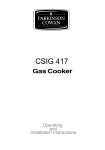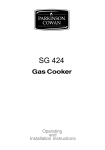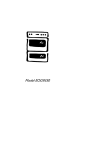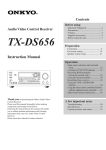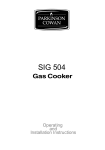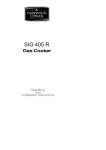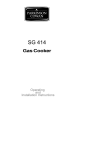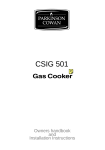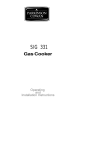Download Electrolux EOG 600 User's Manual
Transcript
Model EOG 600 n EOG 600 c iot Introduction t This gas oven has been designed and manufactured to all the necessary British Standards. It also carries the C.E. mark. The oven complies with European Council Directive 90/396/EEC. It is important that you understand how to use and care for the oven properly before you use it for the first time. We have written this booklet with your safety in mind. Read the booklet thoroughly before you use the oven. Keep the booklet in a safe place so that anyone who uses the oven can read it. Pass the booklet on with the oven if you sell it to someone else. nI or d u For your safety The oven is designed for domestic use to cook food. You must not use it for any other purpose. It is not designed for commercial use. Keep children, babies and toddlers away from the oven at all times. The installation instructions that came with the oven tell you how and where it can be fitted. If the oven is already installed you must make sure that all instructions have been followed. If you are in any doubt ask a competent person. More details on installation on page 4. We have included several drawings to show the right and wrong way of doing things. The right way will have a smiling face by it. A sad face shows something is wrong. RATING PLATE This is situated on the lower front frame of the appliance and can be seen upon opening the top oven cavity door. Alternatively the rating plate may also be found on the back or top of some models (Where applicable). Do not remove the rating plate from the cookers as this may invalidate the guarantee. 2 Contents ` Contents EOG 600 Page Installing the oven 4 General information 5 The cooling fan for the controls 5 Ignition 6 Lighting the oven/grill 7 The grill 9 The grill pan and handle 12 The oven 14 Baking trays and dishes 16 Oven cooking chart 17 Slow Cooking 20 The electronic minute minder 23 Care and cleaning 26 What is wrong and why? 29 Servicing 31 Installation Instructions 33 Technical Data 34 Safety requirements/ventilation 35 Location of appliance 36 Installation 37 Testing 40 Guarantee Conditions 43 3 Installation EOG 600 Installing the oven For your safety This oven must be installed and serviced by a competent person as stated in the Gas Safety (Installation & Use) regulations current edition. It is important that the oven is suitable for your gas supply. Your installer should check the data badge. Cabinet Dimensions This oven must be fitted into a cabinet with a suitable sized aperture. Minimum aperture height 575mm Minimum aperture width 560mm Minimum aperture depth 560mm Location For your safety The use of a gas cooking appliance results in the production of heat and moisture in the room in which it is installed. Ensure that the kitchen is well ventilated: keep natural ventilation holes open or install a mechanical ventilation device (mechanical extractor hood). Prolonged intensive use of the appliance may call for additional ventilation, for example opening of a window, or more effective ventilation, for example increasing the level of mechanical ventilation where present. For further details see page 35. 4 General information To get the best results from your new oven please read these instructions carefully. You should pay particular attention to cooking times and gas mark settings as these may differ from your previous oven. You may find it necessary to adjust these until you are more familiar with the oven. For your safety Do not block any of the oven vents. Never line any part of the oven with aluminium foil. Do not let items which can catch fire or electric mains leads such as kettle flexes trail over any part of the oven. Oven housing units vary widely in construction and finish. To avoid possible damage to the housing unit, you must not leave cabinet doors or flaps above the oven open or partially open when you are using the grill or oven. If you install your oven in a tall oven housing the storage area above the oven will become warm when you use the oven. Do not store perishable foods in the storage area above the oven. The cooling fan for the controls Your oven has a cooling fan. The cooling fan will start to work as soon as you light the grill or oven. You will be able to hear the fan when it is working. The cooling fan may continue to work after you have turned off the oven or grill. It may switch itself on and off until the oven has cooled down. If you want to turn off the electrical supply to the oven, you should not do so until the cooling fan has stopped working. For your safety When you are using the grill or oven warm air will exhaust from the grill cavity and the vents below the control panel. Take care not to stand too close to the oven or grill while in use. 5 General information EOG 600 General information EOG 600 Ignition The grill and oven burners light automatically when you turn on the control. If, for any reason either of the burners go out, the spark ignition will automatically relight it. Please note: You can only use the grill with the door fully or partially open. You cannot use the grill when the door is closed. You cannot use the oven and grill together. You cannot use the oven or grill in the event of a power failure. Connecting to the electricity supply For your safety This appliance must be earthed and protected by a 3 amp fuse. The plug supplied with the oven can be fitted directly to a suitable three pin earthed socket. If you have to change the fuse replace it with a 3 amp fuse which has been ASTA approved to BS 1362. Do not use the plug until you have put the fuse cover back on. If the fuse cover is lost you can get a replacement from an electrical retailer. The correct replacement can be identified by marking or colour coding. If you cut the plug off dispose of it safely as it will be a shock hazard if it is inserted into a 13 amp socket elsewhere in the house. If the ignition system doesn't work there may be a fault with the electrical supply. First, check the socket by trying out another piece of electrical equipment in it, if that works correctly renew the fuse in the plug. If the fuse keeps failing there is a fault in the oven which must be put right. Do not use a fuse with a rating higher than 3 amps. Do not carry out other electrical work. Unplug the oven and tell your installer. 6 Lighting the oven/grill Grill To light: 1 Open the door. Push in the control knob and turn it to the highest setting. This is shown by a large flame symbol. For your safety Never cover the grill pan or grid with foil as this can lead to grill fires Oven To light: 1 Open the oven door. 2 Push in the control knob and turn it to gas mark 9. When the burner has lit there will only be small flames at first. 3 Now turn the control knob to the gas mark you want. 4 Wait until the burner is showing large flames. 5 Close the oven door. 7 Lighting the oven/grill EOG 600 Lighting the oven/grill EOG 600 To turn off any burner 1 Push in the control knob and turn it to the off position. This is shown by a large dot. For your safety When you are lighting any burner check that it has lit before you leave the oven. When you are turning off a burner do not leave the oven until the flame has gone out. 8 The grill We suggest that you run the grill without food for approximately 5 - 10 minutes to burn off any residue from the surface. During this period an odour may be emitted, it is therefore advisable to open a window for ventilation. For your safety You must keep the grill door open when the grill burner is lit. Accessible parts may be hot when the grill is used. Young children should be kept away. Never cover the grill pan or grid with foil as this can lead to grill fires. Heat control The grill gives variable heat settings. The control knob turns to the left from 'OFF' to 'HIGH' and then to 'LOW'. The high setting should be used for fast cooking such as toast. Use a lower setting to cook thicker foods such as chicken after it has been browned on the high setting. You should remember to turn the food regularly. You should not use the grill to keep food warm as it will continue to cook the food. The grill pan should be used on the shelf without the metal plate underneath it. The shelf can be positioned in any of the runner positions. You can reverse the grill pan grid to suit different types of food. If you close the door whilst the grill burner is lit, it will go out and you will hear a continuous 'sparking'. The burner will automatically relight when you open the door. 9 The grill EOG 600 The grill EOG 600 Cooking positions Most food should be cooked on the grid in the grill pan. You can turn the grid over to suit different thicknesses of food. You can place some dishes straight on the grill shelf. This is useful when you are browning the top of food such as cauliflower cheese. Preheating You don't usually need to preheat the grill. You may wish to preheat it for a couple of minutes when you are cooking steak or browning food. Putting food on the grid Place food such as toast, tea-cakes and muffins towards the centre of the grid. If you put food outside this area it may require rotating during cooking. Place food which needs a more gentle heat, such as tomatoes and mushrooms towards the edge of the grid. Arrange meat products and fish to suit their thickness and how you like them cooked. Grill shelf You should use the shelf without the metal plate when grilling. For safety the shelf will only pull out so far. If you want to remove a shelf completely, pull it forward as far as it will go, raise the front edge and lift it out. To put the shelf into a different position, keep the front edge raised, slot the shelf onto the runner, lower the front edge and slide the shelf in. Use shelf position one when toasting and adjust the height of the grid to suit. Shelf positions are counted from the top downwards. Use shelf position one when toasting and adjust the height of the grid to suit. Shelf positions are counted from the top downwards. 10 Dishes, tins and trays should not be placed directly on the oven base as it becomes very hot and damage will occur. For your safety Always remove the grill pan before attempting to adjust the shelf position. Oven gloves should be used when removing or pulling the shelf in and out. For hygiene and safety reasons this appliance should be kept clean at all times. A build-up of fats or other foodstuffs could result in a fire, especially in the grill pan. 11 The grill EOG 600 The grill EOG 600 The grill pan and handle The grill pan is supplied with a removable handle. To attach the handle, place the wirework under the cut out in the pan so that the metal plate hooks over the top of the grill pan. Slide the handle to the left and over the central bump on the grill pan. Ensure the handle is correctly located. It is not necessary to remove the grill pan handle during grilling. Place the grill pan on the shelf so that the pan is positioned centrally beneath the grill. To remove the handle, slide the handle to the right and lift the handle away from the cut out on the grill pan. Note If you require an additional handle for your grill pan, this can be ordered from your local Service Force Centre by quoting part number 311479800\6. 12 To check the progress of the food when using the grill you should withdraw the grill pan on the shelf to attend to food. After removing the grill pan you can rest it on a heat resistant work surface if you need to. Plate warming When using the grill, you can use the shelf below the grill pan to warm plates. Do not put plates on the shelf when the grill burner is turned on and the grill pan is not in place. The heat from the burner will damage the plates. 13 The grill EOG 600 The oven EOG 600 The oven For your safety Never leave the appliance unattended when the oven door is open. Before you use the oven you should wipe it out with a damp cloth. This will remove any dust. We suggest that you run the oven without food for 10 - 15 minutes at Gas mark 7 to burn off any residue from the surface. During this period an odour may be emitted, it is therefore advisable to open a window for ventilation. Heat zones There are zones of heat within the oven. The temperature in the middle is the gas mark you have chosen. The top of the oven is slightly hotter and the lower shelf slightly cooler. The base of the oven is quite a lot cooler. You can make use of these heat zones when you are cooking foods that need different temperatures all at the same time. You can use the base of the oven to warm plates. If you are cooking more than one tray of similar items, for example cakes or biscuits, swap the trays around during cooking. Or you can remove the top tray when the food is cooked and move the lower tray to the higher shelf to finish cooking. Preheating You do not need to preheat the oven for casseroling and so on. Preheat the oven for baking or when you are cooking sensitive food such as Yorkshire puddings, soufflés and yeast mixtures. When you are cooking or reheating frozen or chilled food read the instructions on the packaging. When you need to preheat the oven, we recommend you do so for 20 minutes. 14 Oven shelves The two oven shelves can be slotted into place in any of 5 positions. The top shelf position should be reserved for grilling only. For safety the shelves will only pull out so far. If you want to remove a shelf completely, pull it forward as far as it will go, raise the front edge and lift it out. To put the shelf into a different position, keep the front edge raised, slot the shelf onto the runner, lower the front edge and slide the shelf in. The shelf positions are counted from the top downwards and recommended shelf positions are given in the cooking charts on pages 17, 18 and 19. When cooking always try to leave at least one runner position between shelves to allow the heat to circulate properly. You cannot use the shelf fitted with the metal plate in the top runner position. When you only need to use one shelf you can store the other shelf above or below the one you are using where there is more space. Use the shelf with the metal plate in a higher runner position when cooking on two levels. The recommended shelf positions given in the oven cooking charts give the best results. 15 The oven EOG 600 The oven EOG 600 Baking trays and dishes For your safety Never place cooking dishes, trays and so on over the oven burner. This will damage the oven as well as the ovenware and possibly the cabinet underneath the oven. Leave a gap of 13mm (½") between all dishes and (½") the sides of all Leave a gap of 13mm between the oven heatofcan dishes and so thethe sides thecirculate oven so the properly. heat can circulate properly. DoDo notnot pushpush dishes too far as food dishes tooback far back as will burn if it overhangs flames.the food will burn the if itburner overhangs burner flames. For the best results we recommend that you use a baking tray which is 310mm (12") square. If you use a tray or tin which is larger than this, you may need to turn it around during cooking. Place single dishes on the centre of the shelf. You may need to turn large items around during cooking. Roasting For best results we recommend open roasting using minimal fat or oil to prevent splashing. It is not necessary to cover meat or poultry or wrap food in foil when roasting as this restricts the circulation of heat and will lead to extended cooktimes. If you are using a roasting bag or cover chicken breast with foil, be prepared to allow an extra 10 - 15 minutes for each 1/2kg (1lb). When cooking large items such as turkeys, the use of foil may be required to prevent the breast becoming dry before the rest of the bird is fully cooked. Condensation Condensation may form on the oven. This is quite normal and nothing to worry about. The condensation forms when heat and moisture are present, for example during cooking. Whenever possible try to make sure that food which contains a lot of moisture for example casseroles are covered. If you do notice any condensation, wipe it up straight away. 16 Oven cooking chart 17 Food Roasting meat: Beef Lamb Pork and Veal Gas mark 5 Shelf position 4* Approximate cooking time Rare: 20 mins. per ½kg (1 lb) and 30 mins. Medium: 25 mins. per ½kg (1 lb) and 25 mins. Well Done: 30 mins. per ½kg (1 lb) and 30 mins. 5 4* Medium: 25 mins. per ½kg (1 lb) and 25 mins. Well Done: 30 mins. per ½kg (1 lb) and 30 mins. 5 4* Medium: 30 mins. per ½kg (1 lb) and 30 mins. Well Done: 35 mins. per ½kg (1 lb) and 35 mins. Thoroughly thaw frozen joints before cooking them. * Recommended position for shelf with metal plate. E0G 600 These instructions are for cooking in the oven after it has been pre-heated for 20 minutes. When you are using two shelves use the shelf with the metal plate in the higher position. If you are cooking more than one tray of similar items, for example cakes or biscuits, swap the trays around during cooking or you can take the top tray out of the oven when the food is cooked and move the lower tray to the higher shelf to finish cooking. Always leave at least one shelf position between shelves to allow heat to circulate. The recommended shelf positions give the best results. Put the dishes in the centre of the shelf. You can change the gas marks and cooking times to suit your own tastes. It is important to check that food is piping hot before serving. Oven cooking chart Oven cooking chart Gas Shelf Approximate mark position cooking time 20 mins. per ½ kg (1 lb) and 20 mins. 5 4* Chicken 5 25 mins. per ½ kg (1 lb) and 25 mins. Turkey below 4.5kg (10lbs) 4 15 mins. per ½ kg (1 lb) and 15 mins. 5 over 4.5kg (10 lbs) 4 5 4* 25 mins. per ½ kg (1 lb). Duck and duckling Stuffed poultry Cook as above but calculate weight including stuffing Thoroughly thaw frozen joints before cooking them. The times given above are for open roasting in a preheated oven. If you cover the food with foil or a lid allow an extra 10 - 15 minutes for each ½kg (1lb). Yorkshire pudding - large 7 2* 25-30 mins. - individual 7 2* 15-25 mins. 3½-4½ hours. 5* Cakes: Christmas cake 230mm (9") 2 2¼ hours. 4* Rich fruit cake 180mm (7") 2 2½ - 2¾ hours. 4* 205mm (8") 2 1 hour. 5* Madeira, 180mm (7") 4 15-25 mins. 2* & 4 5 Small cakes 10-20 mins. 2* & 4 7 Scones Victoria sandwich 20-30 mins. 2* & 4 4 180mm (7") 20-35 mins. 2* & 4 4 205mm (8") * Recommended position for shelf with metal plate. Food Poultry: E0G 600 18 Food Pastries: Plate tart (shortcrust) Fruit pie (shortcrust) Mince pies (flan pastry) Profiteroles (choux pastry) Gas Mark Shelf Position Approximate cooking time 6 6 5 4 2* 2* 2* & 4 2 50 mins. interchange after 25 mins. 50 mins. interchange after 25 mins. 15-25 mins. 25 mins. To help pastry brown on the underside cook on a metal plate, or if plates are flat and have no rim underneath, place on baking tray to cook. 2 4 3 3 4* 2 1½-2 hours. 45-60 mins. 50-60 mins. Yeast mixtures: Bread 0.45kg (1lb loaves) 0.90kg (2lb loaves) Rolls and buns 8 8 8 3* 3* 2* 30-40 mins. 30-40 mins. 10-20 mins. E0G 600 Milk puddings Baked sponge pudding Baked custard 19 Puddings: Note: You must soak dried beans then boil them in an open pan for 15 minutes before you add them to any dish. * Recommended position for shelf with metal plate. Oven cooking chart Slow cooking EOG 600 Slow cooking The slow cook setting gives a very low heat in the oven. It is particularly useful when you are cooking soups, stews and casseroles because the long slow cooking will make cheaper, tougher cuts of meat more tender. Some foods such as pastry and biscuits are not suitable for slow cooking because the temperature is too low. Cover all food during cooking to prevent it from drying out. You can uncover food for the last half hour if it is normally served golden brown. Food preparation - slow cooking Joints of meat and poultry l l l l l l l l l l Do not cook meat joints over 2.7kg (6lb). Do not cook poultry over 2kg (4lb 8oz). Cook on the middle shelf of the oven or above. Cook stuffing separately. Cook for at least 6 hours. Only cook joints of pork if you can make sure, by using a meat thermometer, that the temperature inside the joint is at least 88oC. For good air circulation always stand joints on a rack in the roasting tin or casserole. Thaw all frozen meat and poultry before you cook it. Prime cuts of meat do not benefit from slow cooking. Cut off unwanted fat and skin unless it is browned first. 20 Soups, casseroles and stews l l l l l Do not cook casseroles over 2.7kg (6lb). Do not cook two (1.8kg) (2lb) casseroles on slow cook setting at the same time. Cook in the middle of the oven or above. Cover food with a tight fitting lid or tin foil. Cook for up to 9 hours. Vegetables l l l l l l Cut into small pieces. Dried beans must be pre-soaked then boiled in an open pan for 15 minutes before adding to any dish. Place vegetables under meat in casseroles. Cover food with a tight fitting lid or tin foil. To prevent potato dishes from discolouring, add lemon juice. Cook for up to 6 hours. Milk puddings l l l Make the pudding in the usual way. For delicate puddings such as egg custard, place the dish in a bain marie and cover the dish with tin foil. Cook for 2 - 4 hours. Frozen foods Thaw thoroughly before cooking. Thickening Toss meat in flour for casseroles. Alternatively blend cornflour with water and add it at the end of cooking. Flavouring Flavours are retained because there is little evaporation. Adjust seasoning at the end of the cooking time. Liquid Use slightly less liquid because there is little evaporation. Milk and milk products, for example cream Add these towards the end of cooking to prevent them from curdling. 21 Slow cooking EOG 600 Slow cooking EOG 600 Reheating Cool left over food quickly and then put it in the fridge. Do not reheat food using the slow cook setting. Reheat food in the usual way or in a microwave. Only reheat food once. 22 The electronic minute minder 1= (-) DECREASE CONTROL & MINUTE MINDER 2= (+) INCREASE CONTROL ( ) COOKPOT SYMBOL 1 2 The electronic minute minder can indicate the time of day, operate as a minute minder and it can be used to time and switch off the main oven. Please note that this is a 24 hour clock, for example 2.00pm is shown as 14.00. In the following pages we explain how to use the minute minder and set the time of day. Read through them until you are familiar with the procedure. Fig.1 1.SET THE TIME OF DAY When the electricity supply is first switched ON, the display will flash 0.00. See Fig. 1. Press buttons (1) and (2) together. Release buttons, 0.00 will appear in the display as Fig. 2. Within 5 seconds press button (2), 12.00 will show in the display as Fig. 3. Within 5 seconds press and hold either button (1) to decrease or button (2) to increase the time until the correct time of day on the 24 hour clock is reached, e.g.14.30. See Fig. 4. Fig.2 Fig.3 Fig.4 Note: The increase and decrease control buttons operate slowly at first, and then more rapidly. They should be pressed separately. 23 The electronic minute minder EOG 600 The electronic minute minder EOG 600 2. THE MINUTE MINDER IMPORTANT The minute minder can be used to time a set cooking period. At the end of the cook time the minute minder will automatically switch off the main oven if in use. The minute minder gives an audible reminder at the end of any period of cooking up to 23 hours and 59 minutes. To set press button (1) and the display will read 0. 00, see Fig. 5. Release button (1) and press and hold button (2). The display will count up in one minute intervals until the interval to be timed is reached e.g. 30 minutes, see Fig. 6. If necessary press and hold button (1) to achieve the correct time interval. Fig.5 Fig.6 The minute minder will begin to count down once set. The time of day will show in the display. To show the remainder of the cook time. Press button (1). At the end of the timed period the minute minder will click, switching the main oven OFF if in use. An audible signal will sound for up to 2 minutes. The Auto symbol will flash and the cookpot symbol will go out. The time of day will show in the display. See Fig. 7. Fig.7 To stop the sound press button (1). The display will stop flashing and show the time of day, e.g. 15.00. To return the timer to manual press button (1) again. See Fig. 8. If using the main oven it will come on again once button (1) has been depressed. When cooking is complete remove food and turn OFF oven temperature control. Fig.8 24 3. TO CANCEL THE MINUTE MINDER If you change your mind and want to cancel the minute minder. Press and release button (1). Press and hold button (1) and the display will count down in one minute intervals to 0. 00 See Fig. 9. Release button (1). Fig.9 Fig.10 After a few seconds the time of day will show in the display. See Fig. 10. If the main oven is in use this will switch OFF after a few seconds. Fig.11 To reset, press buttons (1) and (2) together. See Fig. 11. 4. THINGS TO NOTE 1. The time of day must be set before the main oven will operate. There will be a few seconds delay before the oven switches on. 2. The minute minder function controls the main oven only and will switch the oven OFF at the end of a timed period. This function is useful if you want to begin cooking now and have the oven switch OFF automatically. 3. If you have used the minute minder to time food cooking in the main oven you will need to reset the timer by pushing button (1) before the oven can operate again. 25 The electronic minute minder EOG 600 Care and cleaning EOG 600 Care and cleaning For your safety For hygiene and safety reasons you must keep this gas oven clean. A build up of fat or other foodstuff could cause a fire. Try to mop up spills and splashes as soon as they happen. But be careful as parts of the appliance will be hot. Do not use any polishes, caustic cleaners, abrasives, washing soda or soap powder except those recommended in this booklet. Please note: If we recommend you use hot soapy water we mean hot water with washing up liquid in it and not any other cleaning product. If you own a dishwasher please read the operating instructions for the machine before you wash any part of your oven. Clean your oven regularly using a cloth that has been wrung out in hot soapy water. Rinse and polish it dry using a soft cloth. When you remove parts of your oven for cleaning do not plunge them into water whilst they are very hot as this may damage the finish of the parts. You must not remove the control knobs when cleaning the control panel. The grill The grill pan, handle and grid should be cleaned with hot soapy water. Mild abrasives such as 'Cif may be used or for more stubborn marks use a scourer or a soap filled pad such as 'Brillo'. 26 The oven Clean the oven interior, the oven shelves, the grill pan and the oven door while they are still slightly warm. This way you can easily remove any splashes and spills. You may use mild abrasives. The heat in the oven will change the colour of the metal plate on the shelf. You must not remove the solid plate from the shelf. You can soak the shelf for a few minutes in hot soapy water to make cleaning easier. If you use any oven cleaners they must have the Vitreous Enamel Development Council (VEDC) seal of approval. Follow the instructions on the cleaning agent and protect the oven burner with aluminium foil to prevent it becoming blocked. Do not allow the cleaning agents to come into contact with the grill burner. Follow these simple rules to make cleaning easier. Do not overfill dishes or they will boil over. Do not use dishes too high in the oven. If you do they may stick to the grill burner. Cover your roasting tins with foil. This will prevent fat splashing. Use a roasting tin which is just large enough for the meat and potatoes. This will help to reduce fat splashing. Dry any vegetables that you are going to roast. If they are wet there will be more fat splashing. 27 Care and cleaning EOG 600 Care and cleaning EOG 600 Cleaning between the outer and inner door glass You can remove the glass from the oven door if you need to. To remove the outer glass 1 Open the oven door so you can get at the two cross head screws on the top of the oven door. 2 Loosen these screws using a pozidrive screwdriver. 3 You should hold the door glass securely in place with one hand, whilst removing the screws completely, with the other hand. If you do not do this, the door glass could fall forward. Still holding the door glass, remove the trim from the top of the door. Note the correct position of the trim. 4 Using both hands, gently tilt the top of the door glass towards you. Lift slightly to disengage the locators at the bottom of the door. 5 Clean the outer and inner glass using hot soapy water and mild abrasives such as 'Cif'. 6 Replace the glass by holding it in both hands and gently placing the locators into the holes of the brackets at the bottom of the door. Push the top of the glass towards the oven door, and make sure the screw location holes line up. Replace the trim on top of the door making sure that it is correctly positioned. You can check this by looking through the air gap on the top of the door and checking that the screw location holes line up. 7 Hold the glass in place with one hand and replace the cross head screws into the location holes, with the other hand. 8 Tighten the screws using a pozidrive screwdriver. Close the door. 28 What is wrong and why? We strongly recommend that you carry out the following checks on your oven before calling a Service Engineer. Problem The oven or grill will not light. Check l l l Check that the oven is switched on at the wall. Check that the power supply has not been interrupted before the cooling fan has had time to cool the oven down. Check that the oven is switched on at the wall and allow the cooling fan to cool the oven down. Check that there is not a problem with your gas supply. You can do this by making sure that other gas appliances such as your central heating or gas fire are working. Problem Food is cooking too quickly or too slowly. Check l Check that you are using the recommended gas marks and shelf positions. See pages 17,18 and 19. Be prepared to adjust the gas mark up or down to achieve the results you want. Problem The oven is not cooking evenly. Check l l l l Check that the oven is installed properly and is level. Check that you are using the recommended temperatures and shelf positions. If you are using a tin or tray which is larger than the one we recommend, be prepared to turn it round during cooking. If you are cooking a large item be prepared to turn it round during cooking. 29 What is wrong and why? EOG 600 What is wrong and why? EOG 600 Problem Having difficulty cleaning any part of the oven. Check l Check that you are following the instructions for care and cleaning. (See page 26). Problem The timer does not work. Check l Check that the timer instructions are being closely followed. (See page 23). Problem The oven or grill burner flame is unstable/noisy. Check l Check that the burner flames stabilise after a few minutes. It may be that the appliance needs to adjust to room temperature. 30 Service and spare parts In the event of your appliance requiring service or if you wish to purchase spare parts please contact your local Service Force Centre by telephoning 08705 929929 Your call will be routed to your local Service Force Centre covering your postcode area. Customers in Ireland should telephone (01) 4090753 Before you call an engineer check through the information under the heading 'What is wrong and why? ' In-guarantee customers should ensure that the checks under the heading 'What is wrong and why?' have been made as the engineer will make a charge if the fault is not a mechanical or electrical breakdown. Please note that it is necessary to provide proof of purchase for any in-guarantee service calls. When you report a problem try to describe the nature of the fault. Always give your appliance's full name, model and serial number. Make a note of this information in this space: Name: Model Number: Serial Number: P.N.C. Number: 31 Servicing EOG 600 Servicing EOG 600 For your safety Maintenance must only be carried out by a competent /qualified person. Do not try to repair or alter/modify the appliance yourself as this could be dangerous. We recommend that your appliance has an annual gas safety check carried out by our approved service organisation. Customer Care Department For general enquiries concerning your Electrolux appliance or further information on products, you are invited to contact our Customer Care Department by letter or telephone as follows: Customer Care Department Electrolux 55-77 High Street Slough Berkshire SL1 1DZ Tel: 08705 950950 * * calls to this number may be recorded for training purposes. The Gas Consumers' Council The Gas Consumers' Council (GCC) is an independent organisation which protects the interests of gas users. If you need advice, you will find the telephone number in your local telephone directory under Gas. 32 INSTALLATION INSTRUCTIONS Serial number on front frame. Data badge on top rear of panel. For your safety Where applicable Natural Gas and L.P. Gas versions of this appliance are available. Check that this model is suitable for the type of supply available. In the interest of safety this appliance must be installed and/or serviced by a competent person, as stated in the Gas Safety (Installation and Use) Regulations Current Editions. 33 TECHNICAL DATA DIMENSIONS Overall Flexible Gas Pipe Minimum Cabinet Solid Gas Pipe Minimum Cabinet Maximum Cabinet Weight of Appliance Minimum Clearance top of Appliance to Roof of Cabinet Height 595 Width 595 Depth 595 575 560 575 575 600 34kg 560 570 560 N/A 3mm (1/8") CONNECTIONS Gas Flexible Hose Solid Pipe Electrical Rear top right hand side of appliance Rc½ (½" B.S.P.. Female). Right hand side of appliance above grill Behind control panel Rc¼ (¼" B.S.P. Female) Rear of appliance at bottom left hand side 240V a.c. 50Hz Fused to 3 amp. Mains 3 core cable and moulded plug. GENERAL Minute Minder Pressure test point Solenoid valve Diehl Type 13/47-024 Top right hand corner behind fascia. Teddington SOVRBB01G IGNITION Spark Generator Spark Gap GRILL Burner Heat Input Injector Marking Flame Suppressed H.T. spark 240V APCO D9805/1 3-4mm Natural Gas Steel tubular burner with expanded metal frets. 2.8kW (9556 Btu/h) 123 OVEN L.P.Gas 2.8kW (201 g/h) 089 Natural Gas L.P.Gas Burner Sheet metal construction mounted transversely at rear of oven. Heat Input 2.4kW (8189 btu/h) 2.4kW (172 g/h) Injector Marking 108 078 Flame Supervision Device Diamond 'H' G.S.D. 100/28 Diamond 'H' G.S.D100/30 Thermostat Diamond 'H' 1100/141/B2 Diamond 'H'1100/142 /B2 Thermostat By-Pass Marking 74 79 34 IMPORTANT - SAFETY REQUIREMENTS This appliance must be installed in accordance with the Gas Safety (Installation and Use) Regulations Current Editions. Detailed recommendations are contained in the following British Standard Codes of Practice BS.6172, BS.5440: Part 2 and BS.6891. All British Standards must be 'Current Editions'. PROVISION FOR VENTILATION This appliance is not connected to a combustion products evacuation device. It shall be installed and connected in accordance with the current installation regulations. Particular attention shall be given to the relevant requirements regarding ventilation. The room containing the appliance should have an air supply in accordance with BS. 5440: Part 2 Current Edition. All rooms require an openable window or equivalent and some rooms will require a permanent vent as well. For room volumes up to 5m³ an air vent of 100cm² is required: for room volumes between 5m³ and 10m³ an air vent of 50cm² is required. If the room has a door that opens directly to the outside, no air vent is required. For room volumes that exceed 11m³ no air vent is required. If there are other fuel burning appliances in the same room, BS.5440: Part 2 Current Edition should be consulted to determine the requisite air vent requirements. Prolonged intensive use of the appliance may call for additional ventilation, for example opening a window, or more effective ventilation, for example increasing the level of mechanical ventilation where present. 35 LOCATION OF APPLIANCE The appliance may be located in a kitchen, a kitchen/diner or bedsitting room, but not located in a bathroom, shower room or garage. It is essential that there is a minimum clearance of 3mm between the top surface of the appliance and the inside top of the cabinet. The unit must be fitted into a cabinet conforming to Fig. 1. The following internal dimensions are particularly important. Solid Pipe Flexible Pipe Height Width Depth Depth 575............Minimum 560............Minimum 560........... Minimum 575............Minimum 600..........Maximum 570..........Maximum N/A.........Maximum N/A.........Maximum NOTE: Where a cupboard door with a handle is situated above the appliance, we recommend a minimum clearance gap of 5mm between fascia top trim and door. If the appliance is to be installed next to a cupboards' doors or draws, we recommend that the cabinet heat deflectors, supplied with the appliance be fitted. These are located behind the front frame and secured in position by the fixing screws (see Installation Section). This oven unit may be used in a Built-in or a Built-under situation. If the appliance is to be Built-under a hob, it is recommended that the hob be installed before the oven unit. L.P.G. cookers MUST NOT be installed below ground level, i.e. in a basement, or aboard any boat, yacht or other vessel. 540 600 max 36 560 m 570 in max FIG.1 min 560 2000 recommended 5 575 min 595 570 600 600 min INSTALLATION Flexible Pipe Installation. FITTING THE APPLIANCE AND CABINET It is recommended that a 3/8" 1100mm long angle bayonet flexible hose (B.F.S.) and a ½" straight socket (B.F.S.) be used for the installation. However any approved hose of the correct length can be used. IMPORTANT: Flexible tubing used must comply with BS 669 current editions. L.P.G. flexible connections must be of a type suitable for L.P.G. and capable of operation up to 50mbar and carry a red stripe, band or label. NOTE: Only liquid sealants can be used in threaded gas connections. Do not use P.T.F.E. tape. 1 Make suitable arrangements for gas and electric supplies into the installation site. Preferably a junction box or a 3 pin earthed socket should be situated at the back of the cabinet below the oven. 2 The electrical connection to the appliance is at the rear bottom right hand side; the junction box or socket should be positioned accordingly. 3 Fit the cabinet as Fig.1, make sure that it is level. 4 When unpacking the appliance keep it on it's polystyrene base until it is put into the cabinet to avoid damage. NOTE: It is imperative that the appliance is left in the base to protect both the appliance and the floor. Do not allow young children to play with any part of the packaging. 5 Remove the oven door (See section B on page 41). Remove the fascia panel (See section A on page 39). 6 If the gas supply bayonet and wall fixing bracket are to be located behind the appliance it must be located in the shaded area as indicated in Fig.3. 7 Connect flexible hose to the gas inlet supply block see Fig.3. The hose should be long enough to allow the appliance to be withdrawn from the cabinet. N.B. Two people will be required to carry out the lifting procedure. 8 Position the appliance in front of the cabinet and run the supply cable (See Section 2) through the cabinet and connect to the junction box or socket. Ensure that the supply is isolated at this stage. Connect flexible hose to the bayonet connector. Warning: Do not attempt to lift this appliance by the handle. 9 Lift the appliance into the cabinet making sure the hose and cable are not trapped. Push the appliance as far back as it will go. 10 Centralise and fix the appliance using the four wood screws provided, in the position indicated in Fig.2. NOTE: If fitting the cabinet heat deflectors they should be located behind the front frame and secured in position by the above four wood screws. 11 Carry out gas soundness check. NOTE: Check gas supply pressure before fitting fascia (See SECTION 3). HEAT DEFLECTOR FIG.2 FIXING POINTS 37 INSTALLATION Solid Pipe Installation 430 FITTING THE APPLIANCE AND CABINET. 1 Make suitable arrangements for gas and electrical supplies into the installation site. Preferably a junction box or a 3 pin earthed socket should be situated at the back of the cabinet below the oven. 2 Fit cabinet as Fig. 1, making sure that it is level. 3 When unpacking the oven keep it on it's polystyrene base until it is put into the cabinet to avoid damage. Do not allow young children to play with any part of the packaging. NOTE: It is imperative that the appliance is left in the base to protect both the appliance and the floor. 4 Remove the oven door. (See section B on page 41). GAS INLET SUPPLY BLOCK 5 Solid gas pipe installation: i) Remove the fascia control panel (see section A on page 40). ii) Slacken and remove the union nut on the gas supply elbow on the right hand side of the control panel. See Fig.7. iii) Remove the two screws on the gas inlet block Fig.3. 280 iv) Withdraw the gas inlet block and pipe assembly from the back of the appliance v) Remove the union elbow from the inlet block and pipe assembly. The elbow will be required in the final installation. 120 vi) The union elbow should be connected to the gas supply pipe via a standard ¼"B.S.P. straight connector. Fig.3 6 Install the gas supply pipe on site complete with 120 the union elbow (See Fig.4). Note the orientation of the elbow, the connection must be upwards. 7 Position the appliance in front of the cabinet and run the supply cable (See Section 2) through the cabinet and connect to the junction box or socket. Ensure that the supply is isolated at this stage. N.B. Two people will be required to carry out the lifting procedure. Warning: Do not attempt to lift this appliance by the handle. 8 Lift the appliance into the cabinet making sure the gas supply pipe enters the duct in the rear of the appliance and the cable is not trapped by the appliance. Push the appliance as far back as it will go. Ensure the supply pipe comes through the control panel and pull through any slack cable. 9 Centralise and fix the appliance to the cabinet using four wood screws in the position indicated in Fig.2. NOTE: If fitting the cabinet heat deflectors they should be located behind the front frame and secured in position by the above four wood screws. 10 Tighten the union nut into the supply elbow. 11 Carry out gas soundness check NOTE: Check supply pressure before fitting fascia (See Section 3). 225 75 mm 500 FIG.4 38 2. CONNECTION TO ELECTRICITY SUPPLY WARNING: This appliance must be earthed, do not earth this appliance to the gas supply piping. This appliance must be connected to a 220V-240V a.c. 50Hz supply which incorporates a 3 ampere fuse. If any other type of plug is used it should incorporate a 5 ampere fuse in either the plug or adapter or at the distribution board. The appliance is supplied with 2 meters (6.5 ft) of 5 ampere 3 core cable, fitted with a moulded plug. If this proves insufficient to allow the appliance to be plugged into the nearest supply socket, the supply cable can be either:i) Replaced totally by a longer cable at least 0.75mm² nominal cross sectional area (24/0.2). ii) Extended by using a B.E.A.B. approved 3-way sealed flex connector with integral flex clamps. DO NOT EXTEND THE CABLE USING PLASTIC OR CERAMIC CONNECTION TERMINAL BLOCKS AND/OR INSULATION TAPE. If the supply cable is replaced it is recommended that the ends of the new cable all be cut to the same length 60mm, any excess wire being stored inside the mains terminal see Fig.5. Should the supplied cable be required to be threaded through small apertures in the cabinets it can be removed from the mains inlet terminal block see Fig.5. If the supplied plug is cut off dispose of it safely as it will be a shock hazard if inserted into a 13 amp socket elsewhere in the house. FIG.5 To fit a 3 pin 13 amp plug to the end of the appliance cable (Fig.6). Connect the wires as follows: BROWN to the live terminal. BLUE to the neutral terminal. GREEN and YELLOW to the earth terminal. As the colours of the wires in the mains lead of this appliance may not correspond with the coloured markings identifying the terminals in your plug, proceed as follows: The wire which is GREEN and YELLOW must be connected to the terminal in the plug which is marked with the letter 'E' or by the earth symbol or coloured GREEN or GREEN and YELLOW. The wire which is coloured BLUE must be connected to the terminal which is marked with the letter 'N' or coloured black. The wire which is coloured BROWN must be connected to the terminal which is marked with the letter 'L' or coloured RED. FIT A 3 AMP FUSE TO THE PLUG FUSE HOLDER 39 FIG.6 3. PRESSURE TESTING The pressure test point is located on the right hand side of the gas rail. Access to the test point is through a cut out in the top right hand side of the control panel see Fig. 7. 1 Remove the hex head plug, turn anticlockwise from the test point. 2 Connect the pressure gauge to the test point. 3 Check the supply pressure by turning the oven thermostat to Mark 9. Then turn on the electricity supply. Allow the oven burner to light and gas flow open up to full rate. The pressure should be:For Natural Gas 20 mbar For L.P. Gas 28mbar for butane, 37mbar for propane. 4 Turn off the electricity supply and the thermostat; disconnect the pressure gauge and replace the test point plug . Turn on gas supply and check for gas soundness. NOTE: The electrical supply must be connected in order to test the pressure. INLET ELBOW FIG.7 PRESSURE TEST POINT 4. RE-ASSEMBLE THE APPLIANCE 1 2 Re-fit the fascia panel. (See section A below). Re-fit the oven door. (See section B on page 41). A. REMOVAL OF FASCIA PANEL 1 2 Remove the gas control knobs and timer control knobs. Remove the four screws (two each side) which are visible on the underside of the fascia. Fig.8. FIG.8 3 Tilt the bottom of the fascia panel out over. Withdraw the fascia panel by moving it down over to disengage it from the top fixing lugs. 4 Replace in reverse order. NOTE: To prevent the top fascia panel mounts becoming slack, it may be necessary to adjust the top fixing lugs. 40 B. REMOVAL OF OVEN DOOR 1 2 3 4 Open door fully. Rotate the hinge stirrups to there forward positions (See Fig. 9). To remove the door, clear the hinges by raising the door slightly whilst pulling towards you. FIG.9 Reassemble in reverse order. 5. CHECKING THE GRILL HINGE STIRRUP 1 2 Place the grill pan under the grill burner. With the oven door open, turn on the grill tap, check that there is a spark from it's ignition system. This should continue until the burner is alight. 3 There is a safety switch which shuts off the gas supply to the grill burner when the door is closed. Check that it is operational by slowly closing the oven door, the gas supply should be shut off to the burner before the oven door is fully closed. NOTE: The burner will continue to spark. 6. SET THE TIME OF DAY FIG.10 To set the clock (See Fig 10). 1. Turn on electricity supply and ensure that the thermostat is in the off position. 2. Press buttons (1) and (2) together. 3. Release buttons, 0.00 will appear in the display. Within 5 seconds press button (2), 12.00 will show in the display. 1 2 4. Within 5 seconds press and hold either button (1) to decrease or button (2) to increase the time until the correct time of day on the 24 hour clock is reached, e.g.14.30. 7. MINUTE MINDER OPERATION To set press button (1) and the display will read 0. 00. Release button (1) and press and hold button (2). The display will count up in one minute intervals until the interval to be timed is reached e.g. 30 minutes. If necessary press and hold button (1) to achieve the correct time interval. The minute minder will begin to count down once set. The time of day will show in the display. To show the remainder of the cook time. Press button (1). At the end of the timed period the minute minder will click, switching the main oven OFF if in use. An audible signal will sound for up to 2 minutes. The Auto symbol will flash and the cookpot symbol will go out. The time of day will show in the display. To stop the sound press button (1). The display will stop flashing and show the time of day, e.g. 15.00. To return the timer to manual press button (1) again. If using the main oven it will come on again once button (1) has been depressed. When cooking is complete remove food and turn OFF oven temperature control. 41 8. CHECKING THE MAIN OVEN 1 2 3 4 5 6 Turn the main thermostat knob to Mk. 9 and check that there is sparking from the ignition system. This should continue until the oven burner is alight. When the oven burner lights up the sparking should cease. There should be a low gas rate at first to the oven burner which is the flame supervision device (F.S.D.) by-pass rate. When the F.S.D. phial has heated up it opens the F.S.D. valve and the main gas stream flows to the burner. After 1 minute check that the flame covers the full width of the burner and is stable. Set the oven thermostat to Mk. 2, close the oven door and check that after 10 minutes the flame size has reduced. Turn off the thermostat and check that the oven flames go out. GENERAL NOTE Instruct the user on how to use the appliance and its ignition system. Refer the user to the wording in the inside cover which gives advice on the safe operation of the appliance. 42 Guarantee Conditions Standard guarantee conditions We, Electrolux, undertake that if within 12 months of the date of the purchase this Electrolux appliance or any part thereof is proved to be defective by reason only of faulty workmanship or materials, we will, at our option repair or replace the same FREE OF CHARGE for labour, materials or carriage on condition that: The appliance has been correctly installed and used only on the electricity supply stated on the rating plate The appliance has been used for normal domestic purposes only, and in accordance with the manufacturer's instructions The appliance has not been serviced, maintained repaired, taken apart or tampered with by any person not authorised by us All service work under this guarantee must be undertaken by your local Service Force Centre. Any appliance or defective part replaced shall become the Company's property This guarantee is in addition to your statutory and other legal rights Home visits are made between 8.30am and 5.30pm Monday to Friday. Visits may be available outside these hours in which case a premium will be charged. Exclusions This guarantee does not cover: Damage or calls resulting from transportation, improper use or neglect, the replacement of any light bulbs or removable parts of glass or plastic Costs incurred for calls to put right an appliance which is improperly installed or calls to appliances outside the United Kingdom Appliances found to be in use within a commercial environment, plus those which are subject to rental agreements Products of Electrolux manufacture which are not marketed by Electrolux European Guarantee If you should move to another country within Europe then your guarantee moves with you to your new home subject to the following qualifications: The guarantee starts from the date you first purchased your product The guarantee is for the same period and to the same extent for labour and parts as exists in the new country of use for this brand or range of products This guarantee relates to you and cannot be transferred to another user Your new home is within the European Community (EC) or European Free Trade Area The product is installed and used in accordance with our instructions and is only used domestically, i.e. a normal household The product is installed taking into account regulations in your new country Before you move please contact your nearest Customer Care centre, listed below, to give them details of your new home. They will then ensure that the local Service Force Centre is aware of your move and able to look after you and your appliances. France Germany Italy Sweden UK Senlis Nürnberg Pordenone Stockholm Slough +33 (0) 3 44 62 20 13 +49 (0) 800 234 7378 +39 (0) 800117511 +46 (0) 20 78 77 50 +44 (0) 1753 219898 43 NOTES 44 NOTES 45 NOTES EOG600 - 311451308 46 EOG 600 Contents Check List Note: If you require relacements of the item listed below please contact your local Service Force Centre quoting the relevant part number. The loose contents of this pack include:No. OFF DESCRIPTION 2 Cabinet Heat Deflector 1 Grill Pan Handle (411468100) 1 Fixing Kit 1 Grill Pan Grid (311419801) 1 Grill Pan (311409401) 1 Oven Shelf 1 Oven Shelf with Baffle Plate Note : If you require an additional handle for your grill pan. This can be ordered from your local Service Force Centre by quoting part number 311479800/6. 47 EOG 600 IMPORTANT NOTICE In line with our continuing policy of research and development, we reserve the right to alter models and specifications without prior notice. This instruction booklet is accurate at the date it was printed, but will be superseded if specification or appearance are changed. ELECTROLUX 55 - 77 HIGH STREET, SLOUGH, BERKSHIRE, SL1 1DZ TELEPHONE 0870 5 950950 Part Number:311451308 © Electrolux Household Appliances Limited 2001 47
















































